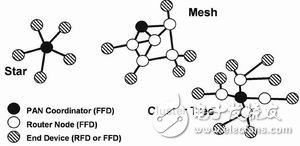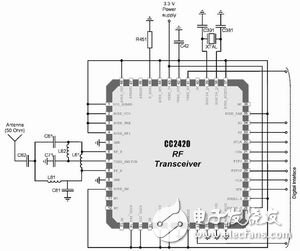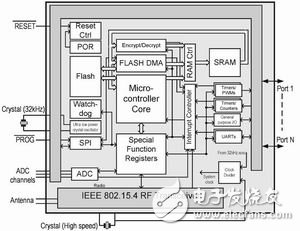ZigBee/IEEE802.15.4 Overview
OverviewThe ZigBee Alliance [2] passed the ZigBee specification in December 2004. It is an open, global standard for low-power, low-cost wireless embedded networks. Table 1 lists some of the applicable areas for ZigBee solutions.
Application area
Energy management and auxiliary functions:* Thermostat
* Heating, Ventilation, Air Conditioning (HVAC)
* Control of curtains such as blinds
Light control system:* Power outlet
* Light modulator
* Switch
* remote control
Environmental and agricultural monitoring:* Temperature
* Carbon dioxide
* Humidity
* Vibration
industry:
* Industrial equipment monitoring
* Conventional wireless embedded sensor network
* Total control
* Asset tracking
Automatic meter reading system:* Electricity
* Qi
* Water
Health Care / Medical:* Patient monitoring
Security alarm system:* Family Safety
* Smoke detection
* Burglary alarm
·Water leakage system
Consumer Electronics System:* remote control
* ZigBee-enabled mobile phones, for example, support for remote master controller functions
·PC peripherals
ZigBee is a standard established on the reliable physical layer (PHY) and media access layer (MAC) defined in IEEE 802.15.4 [1]. Above the PHY and MAC layers, ZigBee defines mesh, star, and cluster tree topology with data security features and interoperable application interfaces.
ZigBee specification
The ZigBee specification was jointly developed by the ZigBee Alliance, which defines the network, security and application layer based on IEEE 802.15.4 PHY and MAC layer. The ZigBee Alliance also develops specifications for interoperability and compatibility testing
The main function of the ZigBee network layer is to discover devices and establish wireless links between devices. The network layer supports three network topologies, star networks, mesh networks (peer-to-peer) and clustered tree network structures. Figure 1 shows the above three topologies.
Mesh networks have high reliability and scalability because they can provide more than one network path. A network like this also has so-called "self-healing" functionality. For example, if a router node fails, data will be transmitted by other routers in the network, provided that the density of the router nodes is large enough.

Figure 1 ZigBee network type
The establishment of a ZigBee network is very simple because the formation of the network is done automatically. In addition, the ZigBee network is also very measurable.
IEEE802.15.4 defines two types of devices; reduced functional devices (RFDs) and full-featured devices (FFDs). In a ZigBee system, these two types of devices refer to physical device types.
In a ZigBee network, a node can have three roles: ZigBee Coordinator, ZigBee Router, and ZigBee End Device. These are the logical device types of ZigBee.
The main responsibility of the ZigBee Coordinator is to set up the network and set their main parameters. (For example, select RF channels, assign different network addresses). It can extend the communication range of the network through the ZigBee router. These routers can also serve as repeaters between two devices that are too distant to communicate directly.
FFDs can communicate with RFDs or other FFDs, but RFDs can only communicate with FFDs. RFDs are designed for extremely simple applications, such as light switches or passive infrared sensors; they do not need to emit large amounts of data, but only need to communicate with an FFD at a certain time. Therefore, RFD only requires the use of minimal resources and memory space and has a lower cost compared to FFD. FFD can be used to implement three logical device types of ZigBee but RFD can only serve as a terminal device.
IEEE 802.15.4 and ZigBee RF-IcsUsing submicro-level COMS technology, highly integrated receiver and transmitter architecture, optimal system partitioning (hardware/software) and optimized embedded software for low power consumption, these are all up to IEEE 802.15. 4/ZigBeeRF-ICs and system bottom cost, key factors for low power requirements.
Current RF-ICs use highly integrated RF structures such as zero-IF or low-IF receivers and direct conversion transmitters. The typical RF transceiver chip that conforms to the IEEE802.15.4 specification is the CC2420 from Chipcon. This is a 2.4GHz RF transceiver chip with low power consumption and can be quickly applied to ZigBee products. The chip uses 0.18_m CMOS technology, making it highly integrated with digital hardware features and a complete RF transceiver in a small chip area. The receiver uses low-IF frequency conversion receivers and the transmitter uses direct conversion transmission. In terms of selectivity and sensitivity, the performance of the CC2420 exceeds the performance specifications required by the IEEE 802.15.4 standard and ensures long-distance, effective, and reliable communications.
Figure 2 shows the application circuit diagram of the CC2420RF transceiver chip. It can be seen that due to its high degree of integration, the number of peripheral components required is minimal. CC2420 must connect external one-chip computer in actual application.
The RF transceiver chip configuration and data communication are all accomplished through the SPI interface. Some of the MAC layer functions with strict timing requirements are included in the RF transceiver chip, such as CRC check, encryption, and some timing functions. Most of the MAC layer functions are implemented in software. These softwares run on the same single-chip microcomputer together with the ZigBee protocol stack and application software.

Figure 2 Application Circuit of IEEE 802.15.4 RF-Transceiver Chip, External Microcontroller Not Labeled
Low power consumption is the most critical issue for most ZigBee systems. Therefore, the low current consumption of the ZigBee RF transceiver chip and microcontroller is especially important. However, it is equally important that the ultra-low power consumption in sleep mode and the extremely short time required from sleep to wake up. For example, a ZigBee technology light switch (which is a typical ZigBee terminal device) operates in most cases in a beaconless mode and transmits data only when an interrupt is triggered, such as a key press. In order to prolong the life of the battery, the current in the sleep mode must be extremely low.
Chipcon uses its own RF transceiver chip CC2420 and Renesas microcontroller M16C62P to make a ZigBee reference design that demonstrates its ultra-low power consumption. The condition is that in the case of peer-to-peer network communication, the inspection is performed at a rate of 1 Hz, and a battery with a battery capacity of 1800 MAh can be used for more than 10 years.
CMOS technology makes it possible to develop a true ZigBee system-on-a-chip. Such a chip should include an IEEE 802.15.4 RF transceiver, microcontroller, programmable/data memory (flash and RAM), and necessary peripheral devices. Because SOC has high integration, miniaturization and the most important high cost efficiency. It is therefore expected that the SOC will become increasingly important for ZigBee/IEEE 802.15.4 systems. Figure 3 shows a simple block diagram of the ZigBee SOC

Figure 3 Theoretical ZigBee SoC Block Diagram
How to implement a solution that conforms to the ZigBee protocol
The best way to develop an end product that conforms to the ZigBee protocol and get ZigBee certification through ZigBee is to develop on a development platform that meets the specifications set by the ZigBee Alliance.
A ZigBee-compliant development platform can be obtained from different ZigBee technology providers. The content included is usually as follows
* PCB BOARD reference design
o IEEE 802.15.4-compliant and tested RF transceiver chip
o Microcontroller
o Necessary external components, such as components needed for antenna matching, crystal load capacitance, decoupling capacitors, etc.
o Sensor/brake connection (this will vary from platform to platform)
* Software
o Necessary MAC layer functions
o ZigBee software protocol, including application framework
The ZigBee Alliance defines testing and interoperability methods so that ZigBee platform vendors provide ZigBee-compliant development platforms.
The ZigBee compliant platform can be represented as a reference design that can be duplicated by the designer, or as a standalone RF module. It is a general-purpose platform and can be used in different ZigBee applications. ZigBee-compliant platforms that are optimized over time, such as terminal devices, will be offered.
In order to shorten development time and reduce test costs, a basic requirement is that manufacturers of ZigBee end products should use the ZigBee development platform. Use a suitable ZigBee application software interface based on the features described in the final product. Product-specific application software needs to be written.
According to the publicly available ZigBee application software interface, only ZigBee-certified products have the ZigBee logo. The final product must be tested by one of the two designated ZigBee testing institutes (TUV Rheinland or NaTIonal Technical Systems). In addition, the final product must pass the ZigBee interoperability test (this will be further defined by the ZigBee Alliance). The ZigBee Alliance defines the commercial conditions for the use of this logo for non-ZigBee Alliance members who have developed ZigBee Certified products and want to use the ZigBee logo.
It is important to note that it is not part of the ZigBee qualification test that is recognized by the standard. The most important frequency specifications for radio equipment operating in the 2.4 to 2.4835 GHz band are ETSI EN 300 440, ETSI EN 300 328, FCC CFR Part 15 and ARIB STD-T66.
Square Hole Breadboard,400 Tie Point Breadboard,Makeronics Breadboard,Small Solderless Breadboard
Cixi Zhongyi Electronics Factory , https://www.zybreadboard.com